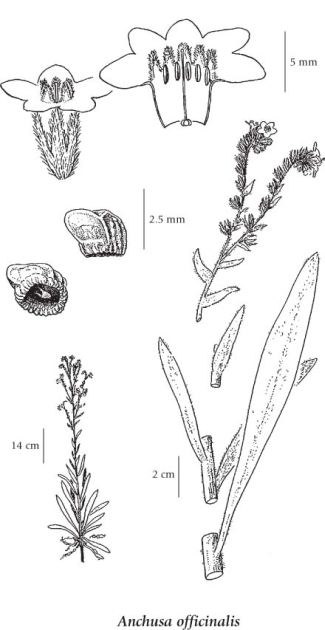Anchusa officinalis L.
alkanet (common bugloss)
Boraginaceae (Borage family)
Introduction to Vascular Plants
alkanet (common bugloss)
Boraginaceae (Borage family)
Introduction to Vascular Plants
Species Information
General:
Biennial or perennial herb from a taproot, softly spreading-hairy; stems often several, 30-80 cm tall.
Leaves:
Basal and lower leaves stalked, oblanceolate, 6-20 cm long (stalk included) and 1-2.5 cm wide, the others gradually reduced upwards, becoming unstalked and more lanceolate, alternate, entire.
Flowers:
Inflorescence a coiled cluster; petals blue-purple, fused into a tube 6-11 mm long that spreads (6-11 mm wide) at the top to 5 tooth-shaped lobes, throat closed by 5 white, hairy bulges; calyx lobes 5, lanceolate, stiff-hairy.
Fruits:
Nutlets 4, clustered together, horizontal, squat, asymmetric or conical, concave and with a thickened rim at the base, 2 mm high, 3-4 mm long.
Illustration

If more than one illustration is available for a species (e.g., separate illustrations were provided for two subspecies) then links to the separate images will be provided below. Note that individual subspecies or varietal illustrations are not always available.
Illustration Source: The Illustrated Flora of British Columbia
Ecology
Ecological Framework for Anchusa officinalis
The table below shows the species-specific information calculated from
original data (BEC database) provided by the BC Ministry of Forests and Range.
(Updated August, 2013)
The table below shows the species-specific information calculated from
original data (BEC database) provided by the BC Ministry of Forests and Range.
(Updated August, 2013)
| Site Information |
Value / Class |
||
|
Avg |
Min |
Max |
|
| Elevation
(metres) |
879 | 879 | 879 |
| Slope
Gradient (%) |
15 | 15 | 15 |
|
Aspect (degrees) |
210 | 210 | 210 |
| Soil
Moisture Regime (SMR) [0 - very xeric; 4 - mesic; 8 - hydric] |
4 | 4 | 4 |
| Modal
Nutrient Regime
Class |
D | ||
| #
of field plots species was recorded in: |
1 | ||
| Modal
BEC Zone Class |
|||
|
All BEC Zones (# of stations/zone) species was recorded in |
|||
|
Source:
Klinkenberg 2013
|
|||
Habitat and Range
Dry roadsides and waste places in the lowland, steppe and lower montane zones; rare in SC BC and S Vancouver Island; introduced from Europe.Status Information
Synonyms
Synonyms and Alternate Names:
Anchusa procera Besser ex Link